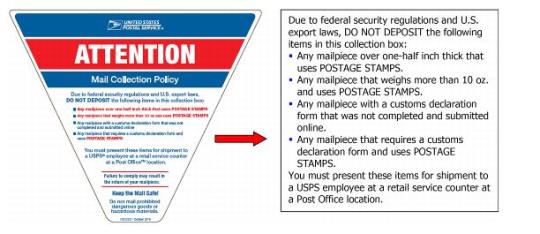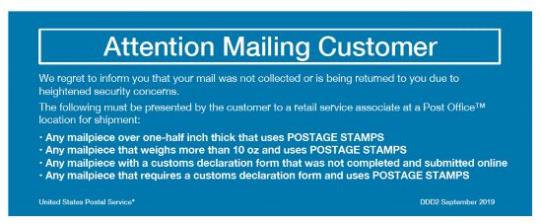Reacting to growing concerns about the safety of U.S. Mail®, the United States Postal Service® enacted the Aviation Mail Security program in 1996, which prohibited customers from depositing any stamped mailpieces weighing 16 ounces or more in its collection boxes.
On August 16, 1996, all mailpieces weighing 16 ounces or more had to be presented in person to a retail clerk or letter carrier. The action was taken to enhance security measures and to protect the traveling public, as well as Postal Service™ employees and contractors, who transport U.S. Mail.
In 2007, the Postal Service modified the Aviation Mail Security rule by decreasing the weight allowance to 13 ounces. In October of that year, mailpieces weighing 13 ounces or more, bearing only stamps as postage, and not accepted by a Postal Service employee at a retail counter were prohibited from entering the mail stream via collection boxes and Post Office™ mail slots. The policy was enacted to promote the safety of Postal Service employees, customers, transportation networks, and the U.S. Mail.
Once again, the Postal Service is modifying the weight restriction and adding a size restriction for mailpieces dropped into collection boxes bearing stamps.
Effective October 1, 2019, mailpieces bearing stamps for postage that are more than one-half inch thick or weigh more than 10 ounces will be prohibited from entering the mail stream through collection boxes, building mail chutes, and Post Office mail slots.
This modification was made out of an abundance of caution and to provide optimal security for Postal Service employees, customers, transportation networks, facilities, and the U.S. Mail.
n The Postal Service is modifying its Aviation Mail Security initiative, which was first enacted in 1996.
n Effective October 1, 2019, mailpieces bearing stamps for postage that are more than one-half inch thick or weigh more than 10 ounces will be prohibited from entering the mail stream through collection boxes, building mail chutes, and Post Office mail slots.
n Customers who need to mail packages with postage stamps that are larger than one-half inch thick or heavier than 10 ounces must conduct the transaction at a Post Office retail counter.
n This modification increases the safety and security of Postal Service employees, customers, transportation networks, facilities, and the U.S. Mail.
1. What is happening?
n The Postal Service is once again modifying the Aviation Mail Security initiative.
n Beginning October 1, 2019, mailpieces bearing stamps for postage that are more than one-half inch thick or weigh more than 10 ounces will be prohibited from entering the mail stream through collection boxes, building mail chutes, and Post Office mail slots.
n This modification increases the safety and security of Postal Service employees, customers, transportation networks, facilities, and the U.S. Mail.
2. How long has the Postal Service had an Aviation Mail Security program?
The Aviation Mail Security program began in 1996 with a 16-ounce restriction on stamped mailpieces. The rule was modified in 2007 when the weight restriction decreased to 13 ounces.
3. How will the change affect employees?
n Postal Service letter carriers will be required to more closely scan the mail collected from residences and collection boxes.
n Carriers have been instructed not to accept packages that fit the restricted criteria, even in face-to-face transactions. See Poster 84.
n Carriers will instruct customers to take these items to the Post Office and conduct a transaction at the retail service counter.
n Items that cannot be returned immediately are to be isolated and returned to sender via surface transportation only.
n Mail that is returned to sender will have a Customer Return Label (DDD2) attached explaining the restrictions and reason for return.
4. How disruptive will this change be for customers?
This change will primarily affect customers who ship heavier mailpieces using postage stamps and deposit them in their neighborhood collection box or Post Office lobby drop. These customers can use Click-N-Ship® on usps.com to print shipping labels from their computer. The mail carrier will pick up the boxes while delivering mail that day, or they can ship boxes from their neighborhood Post Office.
5. How many packages are dropped in collection boxes, mail chutes, and Post Office mail slots each year?
A recent study showed approximately 169,000 stamped packages per week are dropped into collection boxes for mailing.
6. How many collection boxes, mail chutes, and lobby mail slots are there?
The Postal Service currently has more than 142,000 collection boxes nationwide and 65,000 lobby mail slots.
7. Can customers still use self-service kiosks to purchase postage?
Yes, customers can generate postage using the kiosks, and those packages with postage labels can be dropped into the package slots at the Post Office. Customers cannot drop packages with postage stamps generated from a kiosk into package slots at the Post Office. Customers who need to ship a package using postage stamps must go to the retail counter and hand the package to the clerk.
8. Will the labels on the collection boxes and Post Office mail slots reflect this change?
Yes.
9. When will the labels be changed?
The labels will be changed by October 1.
10. What will the new labels look like and say?

11. What happens to stamped mailpieces weighing more than 10 ounces or more than one-half inch thick that are dropped in collection boxes after October 1?
Mailpieces bearing stamps for postage and exceeding the weight or size restrictions that are deposited in collection boxes, mail chutes, or lobby mail slots after October 1 will be returned to the sender.
Packages will be returned with this label attached to the mailpiece:

12. What if there is no return address shown?
The supervisor, manager, or postmaster will contact the addressee by phone and describe the mailpiece to the addressee, providing the city and state of the postmark, if possible. The addressee should be asked:
a. Are you expecting the package?
b. If yes, does this mailpiece contain anything liquid, fragile, perishable, or potentially hazardous such as lithium batteries or perfume?
If the addressee is expecting the mailpiece and confirms that it does not contain anything liquid, fragile, perishable, or potentially hazardous, the supervisor, manager, or postmaster must:
n Identify the mailpiece via a $0.00 PVI, meter strip, or AVSEC stamp.
n Cancel the postage (if not already canceled).
n Apply Label 127, Surface Transportation Only, and transport the mailpiece via surface transportation only.
The supervisor, manager, or postmaster must contact the Inspection Service if the addressee:
n Has no phone number that can be identified by using directory assistance, the phone book, or Internet;
n Is not expecting the package; or
n Cannot confirm that the mailpiece does not contain anything liquid, fragile, perishable, or potentially hazardous.
— City Delivery, Delivery Operations, 9-26-19
